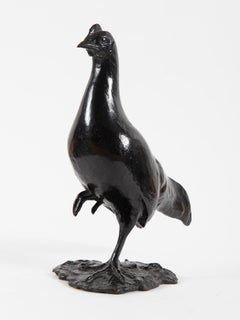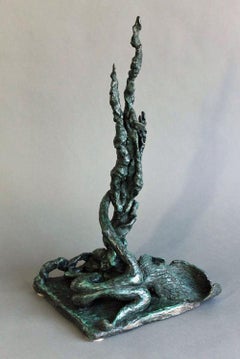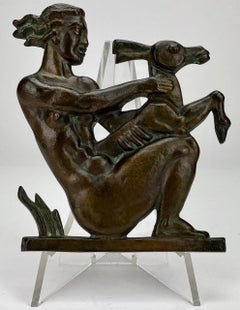François Pompon Art
to
4
Overall Width
to
Overall Height
to
4
1
1
2
2
1
2
2
1
1
1
1
1
1
1
2
2
2
1
5
9,475
2,687
1,375
1,358
4
Artist: François Pompon
White Bear
By François Pompon
Located in PARIS, FR
White Bear
by François POMPON (1855-1933)
Amazing original edition sculpture made in white mat porcelain biscuit.
Stamped in the paste " S – Sèvres – Manufacture nationale France "...
Category
1930s Art Deco François Pompon Art
Materials
Porcelain
Polar Bear
By François Pompon
Located in PARIS, FR
Polar Bear
by François POMPON (1855-1933)
An original edition sculpture made in white enameled porcelain biscuit.
Stamped in the paste "S 1927 DN" (S for "Sèvres" – dated 1927 – DN...
Category
1920s Art Deco François Pompon Art
Materials
Ceramic
Poule Cayenne, by François Pompon, 1900's, sculpture, animal, bronze, chicken
By François Pompon
Located in Geneva, CH
Poule cayenne - Poule faisanne, 1st proof, 1906
Bronze with a black patina
28 x 22 13 cm
Signed on the base : POMPON. Seal of the founder Cire Perdue A.A. Hebrard. Numbered (M)
Certi...
Category
Early 1900s Modern François Pompon Art
Materials
Bronze
Pheasant
By François Pompon
Located in PARIS, FR
Pheasant
by François Pompon (1855-1933)
Exceptional bronze with old gilded patina
Cast by Valsuani
Period cast
France
circa 1930
height 8,2 cm
length 14,2 cm
width 3,6 cm
A similar model is represented in "Pompon, Catalog raisonné", Editions Gallimard, RMN, 1995, page 202, n°95B.
Biography:
François Pompon (1855-1933) is known for his animal sculptures whose innovative style is characterized by the simplification of shapes and polished surfaces. Pompon entered as an apprentice in the workshop of his father, Alban Pompon (1823-1907) who was a "compagnon du devoir" of the carpenter-cabinetmakers. Thanks to a scholarship obtained by the parish priest, he left in 1870 for Dijon where he became an apprentice stonemason with a marble worker. He attended evening classes at the School of Fine Arts in Dijon, first in architecture and engraving with Célestin Nanteuil, then in sculpture with François Dameron (1835-1900).
After a short stint in the army in 1875, Pompon arrived in Paris where he became a marble worker in a funeral business near the Montparnasse cemetery. He attended evening classes at the Petite École, the future National School of Decorative Arts. His teachers were the sculptors Aimé Millet (1819-1891) and Pierre Louis Rouillard (1820-1881), also professor of anatomy, who showed him the menagerie of the Jardin des Plantes.
In 1890, François Pompon entered the studio of Auguste Rodin (1840-1917), where he worked as a practitioner at the marble depot, rue de l'Université. He quickly gained the master's confidence since he ran the workshop in 1893. His role then was to pass on the accounts, pay for the marbles and supervise the work. It is in this same workshop that he met Ernest Nivet and Camille Claudel. He worked for a long time as a practitioner for other sculptors such as Jean Dampt...
Category
1930s French School François Pompon Art
Materials
Bronze
Related Items
Woman Lying Down & Growing with Tree bronze sculpture by Yulla Lipchitz
Located in Hudson, NY
Organic, abstract bronze sculpture by Yulla Lipchitz of a woman lying down with a tree.
About this artist: Yulla Lipchitz, née Halberstadt, was born on April 21, 1911 in Berlin, Ge...
Category
1970s Modern François Pompon Art
Materials
Bronze
$3,775
H 16 in W 7 in D 8 in
Diana the Huntress
By Carl Milles
Located in Täby, SE
An Art Deco bronze relief in the style Swedish Graze by an unknown artist inspired by Carl Milles modern classicism. The concept of Swedish Grace was introduced by the English archi...
Category
1930s Art Deco François Pompon Art
Materials
Bronze
Antique French 19th Bronze Equestrian Group Horses Jockeys Statue Sculpture 1895
Located in Portland, OR
A fine late 19th century antique French bronze sculpture group, of a pair of race horses & jockeys, by Paul Louis Emile Loiseau-Rousseau, Paris (1861-1927).
The bronze circa 1895 de...
Category
1890s French School François Pompon Art
Materials
Bronze
$2,800
H 11 in W 16 in D 10.5 in
Large George Aarons Terracotta Sculpture Relief Art Deco Plaque WPA Artist
By George Aarons
Located in Surfside, FL
Two Figures (Mother and son)
9" x 17" terracotta sculpture, signed lower left mounted to wood panel, 15 1/2" x 23 1/2"
George Aarons (born Gregory Podubisky, in St. Petersburg, Russ...
Category
20th Century Art Deco François Pompon Art
Materials
Wood, Terracotta
$2,200
H 15.5 in W 23.5 in D 1 in
Antique French Egyptian Revival Bronze Bust Sculpture Statue "Queen of Babylon"
Located in Portland, OR
A good antique cast bronze sculpture an Egyptian Revival bust "The Queen of Babylon", by the 19th century French sculptor Paul Auguste Gagne, circa 1875.
This rare & unusual bronze b...
Category
1870s French School François Pompon Art
Materials
Bronze
$1,695
H 10 in W 5 in D 4.5 in
Antique 19th Century French Bonze Animalier Brown Bear Statue Sculpture Paris
By Antoine-Louis Barye
Located in Portland, OR
A good antique bronze sculpture of a brown bear by the celebrated French Animalier sculptor Antoine-Louis Barye, circa 1870.
The bronze depicts a brown bear in a dynamic pose, head h...
Category
1860s French School François Pompon Art
Materials
Marble, Bronze
$2,295
H 9.5 in W 9.5 in D 7 in
Antique Silvered Bronze Rooster, France circa 19th Century
Located in SANTA FE, NM
Antique Silvered Bronze Rooster
France, circa 1900
10 1/4 x 9 1/2 (H x D) inches
A very fine and lively bronze statuette of a preening Rooster. Nicely cast and well-carved and in ex...
Category
19th Century French School François Pompon Art
Materials
Silver, Bronze
$1,900 Sale Price
20% Off
H 10.25 in W 9.25 in D 9.5 in
Pair of Prancing Horses, two bronzes signed and numbered by Arno Breker
Located in PARIS, FR
An official artist of the Nazi regime, trained in Montparnasse in the 1930s, Arno Breker continued to sculpt after the fall of the Third Reich, producing large-scale public commissions in Germany and portraits of prominent figures. The two small bronzes presented here, dated around 1978, are part of a long tradition of prancing horses dating back to antiquity. The asymmetrical treatment of the two front legs and the inclination of the head make these two copies of the same artwork a highly decorative pair.
1. Arno Breker, a prolific sculptor, from the Bohemia of Montparnasse to the commissions from the Third Reich ... and from the Federal Republic of Germany
The son of a stone carver, Arno Breker studied fine art and anatomy in his native Elberfeld. At the age of 20, he entered the Düsseldorf Academy of Art. He moved to Paris in 1926, where he continued his training in the studio of Maillol, who dubbed him "the German Michelangelo of the twentieth century". He shared a studio with Alexandre Calder and frequented Jean Cocteau, Foujita, Brancusi, Pablo Picasso and other artists of the bohemian Paris of the time. It was also in Paris in 1933 that he met Demetra Messala, the daughter of a Greek diplomat who posed for Maillol and Picasso, whom he married in 1937. Having won the Prussian Prix de Rome in 1932, he left Paris to stay at the Villa Massimo, the German Academy in Rome.
Returning to Germany in 1934, his style evolved towards a more marked imitation of ancient sculpture. He created two monumental statues for Berlin's Olympic Stadium, before being appointed professor at the Berlin College of Fine Arts in 1937. He came to the attention of the Reich Propaganda Ministry, which awarded him several commissions and provided him with three large studios in which Breker produced many monumental sculptures to the glory of the regime. On June 23, 1940, Breker accompanied Adolf Hitler during a visit to Paris. During the Occupation, his political connections enabled him to intervene on behalf of many artists pursued by the Nazis: for example, he protected Pablo Picasso (then a Communist) from Kommandantur officers.
Most of Arno Breker's work was destroyed in Berlin at the end of the war in 1945 by bombing and intentional destruction perpetrated by soldiers of the victorious powers. After the fall of the Nazi regime, however, Arno Breker was never prosecuted. He opened a new studio in Düsseldorf, where he sculpted until his death in 1991.
He then carried out several public commissions in Germany (Bayreuth, Wuppertal), as well as portraits of numerous personalities, including King Mohammed V of Morocco, Léopold Sedar Senghor (commissioned by the Académie Française in 1978) and the two chancellors of the Federal Republic of Germany, Konrad Adenauer and Ludwig Erhard. The Arno Breker Museum in Nörvenich is now exhibiting some of his artworks.
2. Related artworks: from the Wild Horses of the Quirinal to the Horses of Marly
The prancing horse is a major iconographic theme, found in a series of sculptures from Antiquity, the Renaissance and the Classical Age. Various photos from Arno Breker's studio in Berlin confirm the predominant place of equine representations in his work (alongside male nude statues), and confirm that this reduced version created in 1978 is part of the artist's preferred repertoire.
Prancing horses are generally associated with a male figure in a group that, through a reference drawn from Antiquity, symbolizes man's domination over nature. In this respect, it is very interesting to compare our small bronzes with the horse forming part of a large sculpture by Arno Breker (made in 1936 and probably destroyed in 1945) depicting Alexander taming Bucephalus.
This statue is itself directly inspired by one of the best-known works of 18th-century French sculpture...
Category
1970s Art Deco François Pompon Art
Materials
Bronze
$3,304
H 4.88 in W 4.75 in D 2 in
Original ceramic pendant " Vé et Astrology "
By Jean Cocteau
Located in CANNES, FR
Jean Cocteau ( 1889 - 1963 )
Vé and Astrology ceramic's pendant :
Vé : signed underneath White 1ere variant
( Terre blanche en relief ). page 212
Size: 7 x5.5 cm
catalogue rai...
Category
1950s Art Deco François Pompon Art
Materials
Ceramic
Large Gilt Bronze Sculptures of Cheetahs
Located in Rome, IT
Fantastic pair of gilt bronze Cheetahs sculptures . The item will be well-suited to either an indoor or outdoor setting.
Category
Early 2000s Modern François Pompon Art
Materials
Bronze
Arabesque, Female Ballet Dancer in Motion, Bronze Gray Bas Relief Sculpture Art
By Eric Bransby
Located in Denver, CO
This stunning figurative bas relief sculpture captures a female ballet dancer gracefully poised in the arabesque position, created by the acclaimed Colorado/Missouri artist Eric Bransby (1916-2020). Crafted from bronze and polymer Forton casting, the piece beautifully exemplifies Bransby’s mastery of motion and form.
Provenance:
Collection of the artist, Eric Bransby
About Eric Bransby:
Eric James Bransby was a highly respected muralist, painter, illustrator, and educator. His education at the Colorado Springs Fine Art Center included studies with renowned artists like Thomas Hart Benton, Jean Charlot, Boardman Robinson, and Josef Albers. He also studied at the prestigious Yale School of Fine Art.
Bransby’s career is defined by his exceptional work as a muralist, with notable commissions including the Rockhurst Library Triptych Mural at the University of Missouri, murals at Brigham Young University, the U.S. Air Force Academy...
Category
20th Century American Modern François Pompon Art
Materials
Bronze
$6,400 Sale Price
20% Off
H 40 in W 30 in D 3 in
“Adam and Eve”
Located in Southampton, NY
Very rare Art Deco three dimensional terracotta sculpture of Adam and Eve by the Austrian artist, Virgil Rainer. Hand painted by the artist. Signed bott...
Category
1920s Art Deco François Pompon Art
Materials
Terracotta, Plaster
François Pompon art for sale on 1stDibs.
Find a wide variety of authentic François Pompon art available for sale on 1stDibs. You can also browse by medium to find art by François Pompon in bronze, metal and more. Much of the original work by this artist or collective was created during the early 1900s and is mostly associated with the modern style. Not every interior allows for large François Pompon art, so small editions measuring 9 inches across are available. Customers who are interested in this artist might also find the work of Jean-Léon Gérôme, Yves Klein, and Richard Orlinski. François Pompon art prices can differ depending upon medium, time period and other attributes. On 1stDibs, the price for these items starts at $111,842 and tops out at $111,842, while the average work can sell for $111,842.


